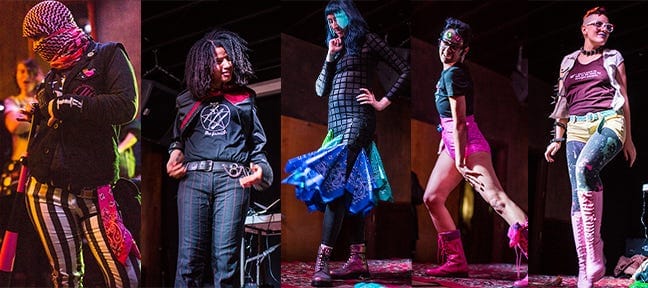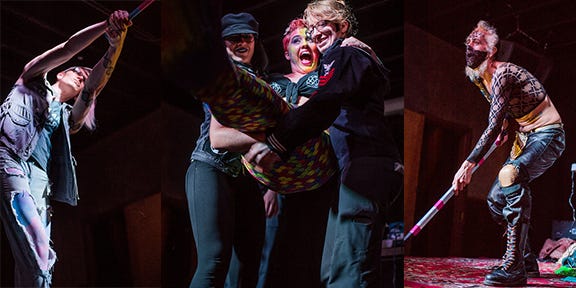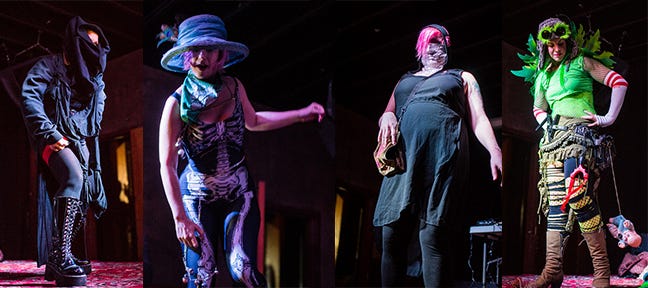Antifa/shion

The lights were dim, the participants masked and tense, knowing full well that all eyes were on them. Cameras flashed in the dark, recording our movements. The crowd was pressed together, waiting, watching, wondering what to expect next.
I could easily be talking about a protest in the streets of Oakland — many of the faces were the same. I had spent many evenings among people much like these, some wearing political teeshirts and ripped jeans, others wearing all black with handkerchiefs obscuring their faces. But tonight, we gathered for a different kind of resistance. Tonight we celebrated our tenaciousness in the face of a Trump presidency. After many weeks of marching in the rain, braving tear gas, shouting our dissent, we had come together to do something particularly daring — we were here to have some fun.
This was “Resist! An Anti-fascist Fashion Show and Radical Bake Sale”, and we were here to raise money for charity as well as to raise our revolutionary spirits. The San Francisco chapter of the Degenderettes, a gender queer feminist art club and the hosts of the event, had chosen groups doing work with refugees and trans people as the recipients of the evening’s fundraising efforts. The move was not entirely altruistic — for some Degenderettes, this was also about ensuring vital resources for our own futures.
It can be difficult amidst cultural and individual trauma to do something that looks, on the surface, to be frivolous. When the world is on fire, it’s tempting to focus attention exclusively on containment and survival. Often, that is necessary. But even the most hardened revolutionary requires respite. And almost everyone enjoys a cupcake, here and there.
While other amazing folks managed our bake sale and our musical accompaniment, I wrangled the anti-fascist fashion show. I can’t think of anything more Bay Area than the mashing together of political angst and protest-ready clothing design, though we certainly aren’t the only purveyors of the combination. Seeing how local artists and activists envisioned what “anti-fascist fashion” meant to them was exciting and inspiring for me, and I wasn’t alone.

“I’m an artist that can do so much in the area of fashion, while my body doesn’t allow me to do much protesting,” said Chelle, who designed several looks and modeled one of mine (a dress made of handkerchiefs that could be pulled off to obscure multiple people’s faces in case of tear gas). “Having a thing that I could do and not worry about if it was a day I could walk or not felt really great. The interactive art aspect of the event was great because it helped us feel like a powerful community that can get shit done more than sitting at home and planning online. Coming to our events and getting our stickers and patches shows more commitment, and a more obvious message of safety to strangers looking for anti fascists.”
From humorous teeshirts offering messages of queer resistance to glittery gas masks, the outfits ranged from playful to useful. One designer wore a fairy version of the popular comic creation Tank Girl, called “Tink Girl”. Another displayed bandoliers carrying seeds instead of bullets, “for the discerning guerilla gardener”. Several wore outfits that offered protection and pockets for medics, the lifeblood of any direct action. Makeup and fabric were both used to obscure the faces of the models to prevent surveillance.
Recent months have seen various symbols of resistance pop up. Safety pins were proposed as a way to silently tell those around you that you would have their backs in a confrontation. Pink pussy hats rallied people together at the Women’s Marches around the world. There is something comforting about these gestures, certainly, but we must recognize the ugly reality in the Bay and across the United States — gestures alone cannot stop the tide of white supremacists, emboldened by a government they feel has their side. Through the medium of fashion, we sought to offer something both powerful and practical to a crowd wondering how they would survive the next four years.

“This event was empowering to me from start to finish. I felt able to involve myself in planning an event, which has previously felt like something unattainable, that only other people do,” said Mack, another designer and model. “The process of planning this event strengthened the sense that I got while preparing for marching over inauguration weekend — that when people work together, we can enable each other to do great things. It was wonderful to have something fun and safe to do together outside of protests and other crisis mode actions. Activities like this event help bring together and strengthen community, so that we can continue to lift each other up and support each other.”
The Bay Area is an environment where concepts like meritocracy and radical self-reliance prosper. At its best, it enables us to come into our own as individuals. At worst, it leaves us isolated, ships adrift in an ocean of collective bootstrapping. We can forget that humans are pack creatures who need each other in varying degrees to survive and thrive. When individualism is held up a community ideal, I find that in practice this means many feel pressured not to ask for help when they need it. The consequences of such detachment can be painful for some, and fatal for others… often felt most strongly by the most marginalized among us.
You can laugh at the idea that parties can save the world, and yes, it certainly sounds superficial on the surface. A party can be a space to enable a community to grow, however; it can offer a container for networks to take root, friendships to deepen, mutual aid to be graciously offered and gratefully received. Joining together in play as well as at work strengthens our connections to each other, and laughing together is humanizing as well as nourishing. I firmly believe dedication to fierce joy assists us in keeping the fire burning for fiercer resistance.
Our anti-fascist fashion show and radical bake sale raised us over $2500 that night in donations that we could pass along to underfunded and unfunded services that protect marginalized people. The pleasure we gained from the event gave us something no money could buy — it gave us hope.

Comments ()